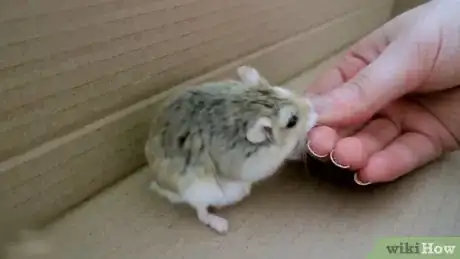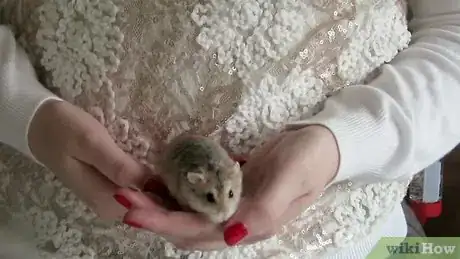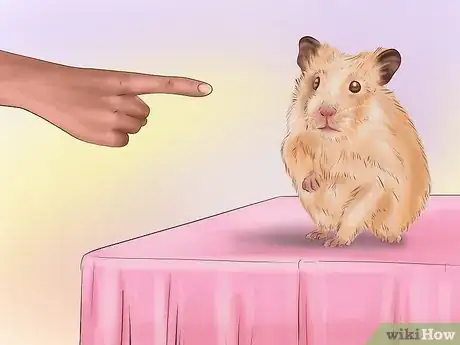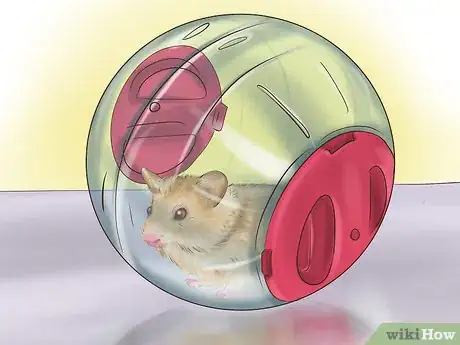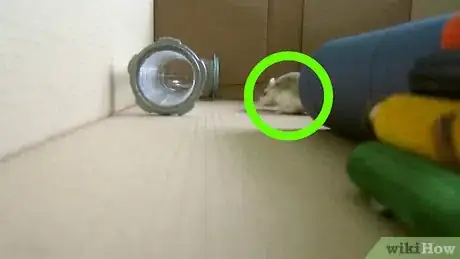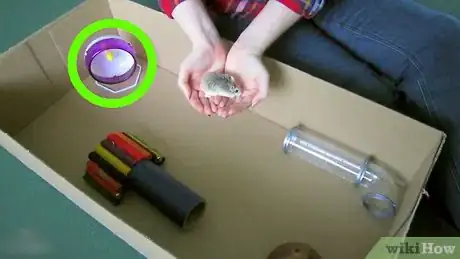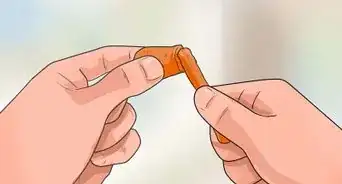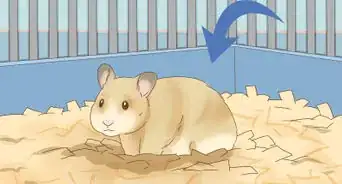This article was co-authored by Pippa Elliott, MRCVS. Dr. Elliott, BVMS, MRCVS is a veterinarian with over 30 years of experience in veterinary surgery and companion animal practice. She graduated from the University of Glasgow in 1987 with a degree in veterinary medicine and surgery. She has worked at the same animal clinic in her hometown for over 20 years.
wikiHow marks an article as reader-approved once it receives enough positive feedback. This article received 26 testimonials and 83% of readers who voted found it helpful, earning it our reader-approved status.
This article has been viewed 521,213 times.
Hamsters are fun animals to keep as pets and are naturally curious and very active. Daily exercise and play are essential to keeping your hamster happy and healthy.[1] Developing a close bond with your hamster and providing him with plenty of opportunities for play and exercise will help him live a long life and become a great pet.
Steps
Handling Your Hamster
-
1Let your hamster adjust to his new environment. Handling your hamster is a great way to bond with your hamster, but he will need some time to adjust to his new home. Give him about 12 to 24 hours to explore his cage and become comfortable with his surroundings. During this time, you can gently talk to him or interact with him, but do not put your hand in his cage.
- Your hamster will need a large cage so that he has plenty of space to run and play. The minimum size cage is 59 cm x 36 cm X 25 cm (approximately 23 in x 14 in x 10 in). Ideally, his cage should also have some tubing and ladders.[2]
-
2Wash your hands. Hamsters do not see very well and typically use their nose to pick up on cues from their environment. For example, if you have just eaten something and then go to handle your hamster, he will smell the food on your hands and may try to bite you. If you have more than one hamster, one hamster could pick up on the scent of the one that you just handled, which could be perceived as being attacked by the other hamster.
- Use unscented soap to wash your hands
- If you are handling multiple hamsters, wash your hands before and after handling each hamster.
Advertisement -
3Place your hand inside the cage. Before your hamster will be comfortable with you handling him, he will first need to get used to your hand. Place your hand in his cage and leave it there for him to sniff and explore. If he tries to bite or nibble your hand, pull your hand away slowly and gently blow on his face to discourage that behavior.
- Hamsters are prey animals, so putting your hand in his cage could resemble a bird reaching down to swoop him up. The more comfortable he becomes with your hand, the less afraid he will be of you picking him up.
- It may take anywhere from a few hours to a few days before he is used to your hand.
- Feeding him treats can also help him get used to your hand being in his cage.[3]
-
4Pick him up. When your hamster no longer sees your hand as a threat, you can start picking him up. Slowly reach into the cage and let him see and sniff your hand first. Then, place one hand under his chest and one hand on his bottom and gently lift him up towards you. Talk to him in a gentle voice and make sure not to squeeze him too tightly.
- Sitting on the ground or standing over a tabletop are the best places to hold him. Your hamster may want to jump, which could cause injury, so you want to make sure that you are as close to a solid surface as possible.
- After you pick him up, you can also try lying back on the floor and allowing him to walk around on your chest.[4]
- If you are having trouble picking him up in your hands, you could also lift him outside of his cage by gently nudging him into a cup or small bowl.
- Keep in mind that hamsters generally do not enjoy being handled for long periods of time.[5] Begin by holding him for a few seconds and gradually increase the amount of time that you hold him.[6] If he gets squirmy, place him back in his cage as gently and slowly as you picked him up.
- Because they are prey animals, hamsters are wary of sudden changes in their environment. Slowly reaching in and picking up your hamster will help reduce his fear that he is being scooped up by a predator.
-
5Do not punish your hamster if he bites. Hamsters generally do not respond to punishment because they cannot make a clear association between the behavior and the consequences. Rather than yelling or hitting your hamster, you can gently blow on his face and say “no” in a firm voice. The air on his face will probably cause him to rear back and squint. That should be enough to discourage him from biting you again.
Playing With Your Hamster Outside of His Cage
-
1Hamster-proof the area. Your hamster will need daily playtime outside of his cage.[7] To make this an enjoyable experience for him, you will need make sure that his play area is safe. For example, you will need to remove or hide any electrical cords that he could nibble on. You should also block any possible areas where your hamster could squeeze or hide in, such as under furniture or between couch cushions.
- If you have other pets, they should not be allowed in your hamster’s play area.
- A clean bathroom is a good area for your hamster to play in. Make sure that the toilet lid is closed so that he does not accidentally fall in the toilet.
-
2Do not use a hamster ball. Hamster balls are a popular way to exercise hamsters٫ but they are in no way safe. They cause unnecessary stress٫ and your hamster can be overheated inside their ball. There is also unavoidable dangers٫ hamster balls limit your hamster's senses to just their vision٫ which is very poor. This means that they won't be able to navigate while in their hamster ball. Hamster balls have barely any ventilation٫ and the holes they do have for ventilation are just big enough for your hamster's limbs to get caught in. Hamster balls can even cause injury٫ and in rare cases٫ death.
- Not only are they extremely dangerous and even cruel٫ they also provide no benefit for your hamster.
EXPERT TIPDr. Elliott, BVMS, MRCVS is a veterinarian with over 30 years of experience in veterinary surgery and companion animal practice. She graduated from the University of Glasgow in 1987 with a degree in veterinary medicine and surgery. She has worked at the same animal clinic in her hometown for over 20 years.Veterinarian
 Pippa Elliott, MRCVS
Pippa Elliott, MRCVS
VeterinarianPippa Elliott, a licensed veterinarian, suggests: "When using an exercise ball, be careful to keep other pets out of the room. Whilst your dog may think chasing a moving ball is great fun, the hamster is likely to be frightened and may become traumatized."
-
3Place him in a large playpen. A playpen is another way that your hamster can play outside of his cage. Ideally, the playpen should be larger than his regular cage. To make the playpen fun for him, place some of his toys inside of it. Supervise him closely so that he does not climb out of his playpen and escape.
- Playpens are available at your local pet store.
-
4Allow him to run around in an open area. You can also let your hamster explore the hamster-proofed area without being in an exercise ball or playpen. If you are in the bathroom, you could place him in the tub and let him run around. Place some of his toys in the open area and create some obstacle courses to keep him interested.[8]
- The obstacle course can be made of common household items, such as empty cardboard boxes and toilet paper rolls.
-
5Look for your hamster if he runs away. Despite your best efforts to hamster-proof the area and keep a close eye on your hamster, he may still find a way to escape and hide. If you cannot find him when playtime is over, check the places where he would be most likely to hide: behind or underneath furniture, between seat cushions, inside of drawers or boxes, etc.
- If you have searched all of these places with no luck, consider placing food near or inside of his cage to encourage him to come back to his cage.
Playing With Your Hamster Inside of His Cage
-
1Place an exercise wheel inside of his cage. An exercise wheel is considered the mainstay of a hamster’s exercise. An exercise wheel with wires or mesh could injure your hamster’s paws, so select an exercise wheel that has a solid bottom. Also, look for one that can attach to one of the interior sides of your hamster’s cage.[9]
- The exercise wheel should be large enough (minimum 12 inches in diameter) to prevent your hamster’s back from bending when he is running on the wheel.[10]
- Listen to the wheel when your hamster is running on it. If it is noisy, you may want to consider moving your hamster’s cage to an area outside of your bedroom. Hamsters are nocturnal animals, so your hamster would likely be running on his cage during the night.[11]
-
2Place toys inside of his cage. Your hamster will want to do more than just run on his exercise wheel. He will also enjoy running through tunnels and having toys that he can nibble on. The chew toys will help keep your hamster’s teeth filed down.[12] Rather than buying a lot of toys at your local pet store, you could make homemade toys.
-
3Supervise your hamster. Although your hamster will likely not escape from his cage, you still want to make sure that his play is safe inside of his cage. For example, if his cage is made of wire, he may try to climb up the sides of the cage. Not only could the wire injure his paws, but he could also get seriously injured if he falls down when trying to climb.[13]
- If you see him trying to climb, you could slowly reach into his cage and gently place him back on the cage floor.
Expert Q&A
Did you know you can get expert answers for this article?
Unlock expert answers by supporting wikiHow
-
QuestionCan we put hamster cage inside our bedroom?
 Pippa Elliott, MRCVSDr. Elliott, BVMS, MRCVS is a veterinarian with over 30 years of experience in veterinary surgery and companion animal practice. She graduated from the University of Glasgow in 1987 with a degree in veterinary medicine and surgery. She has worked at the same animal clinic in her hometown for over 20 years.
Pippa Elliott, MRCVSDr. Elliott, BVMS, MRCVS is a veterinarian with over 30 years of experience in veterinary surgery and companion animal practice. She graduated from the University of Glasgow in 1987 with a degree in veterinary medicine and surgery. She has worked at the same animal clinic in her hometown for over 20 years.
Veterinarian
-
QuestionWhat are the best stores to find a dwarf hamster?
 Pippa Elliott, MRCVSDr. Elliott, BVMS, MRCVS is a veterinarian with over 30 years of experience in veterinary surgery and companion animal practice. She graduated from the University of Glasgow in 1987 with a degree in veterinary medicine and surgery. She has worked at the same animal clinic in her hometown for over 20 years.
Pippa Elliott, MRCVSDr. Elliott, BVMS, MRCVS is a veterinarian with over 30 years of experience in veterinary surgery and companion animal practice. She graduated from the University of Glasgow in 1987 with a degree in veterinary medicine and surgery. She has worked at the same animal clinic in her hometown for over 20 years.
Veterinarian
References
- ↑ http://www.petscorner.co.uk/petopedia/syrian-hamsters/
- ↑ http://www.petscorner.co.uk/petopedia/syrian-hamsters/
- ↑ https://www.aspca.org/pet-care/small-pet-care/hamster-care
- ↑ http://animals.mom.me/hamsters-like-play-with-2550.html
- ↑ http://animals.mom.me/hamsters-like-play-with-2550.html
- ↑ https://www.aspca.org/pet-care/small-pet-care/hamster-care
- ↑ https://www.aspca.org/pet-care/small-pet-care/hamster-care
- ↑ http://animals.mom.me/hamsters-like-play-with-2550.html
- ↑ http://animals.mom.me/hamsters-like-play-with-2550.html
- ↑ http://www.petscorner.co.uk/petopedia/syrian-hamsters/
- ↑ http://animals.mom.me/games-hamsters-love-3158.html
- ↑ http://animals.mom.me/hamsters-like-play-with-2550.html
- ↑ http://animals.mom.me/games-hamsters-love-3158.html
- ↑ http://www.petscorner.co.uk/petopedia/syrian-hamsters/
- ↑ http://www.petscorner.co.uk/petopedia/syrian-hamsters/
- ↑ http://animals.mom.me/games-hamsters-love-3158.html
- ↑ http://animals.mom.me/games-hamsters-love-3158.html
- ↑ http://animals.mom.me/games-hamsters-love-3158.html
- Videos provided by Joy Georgina
About This Article
Wash your hands before you play with your hamster, since hamsters are very sensitive to smells. Place your hand inside its cage and let it sniff your hand. If you like, you can give it treats to help it relax. Once the hamster is comfortable with your hand being in its cage, place one hand under its chest and the other hand under its bottom and gently lift it towards you. Talk to it in a gentle voice and be careful not to squeeze it too hard. Carefully lower the hamster back into its cage when you are finished playing with it. To learn about toys your hamster may like from our Veterinarian co-author, keep reading!


